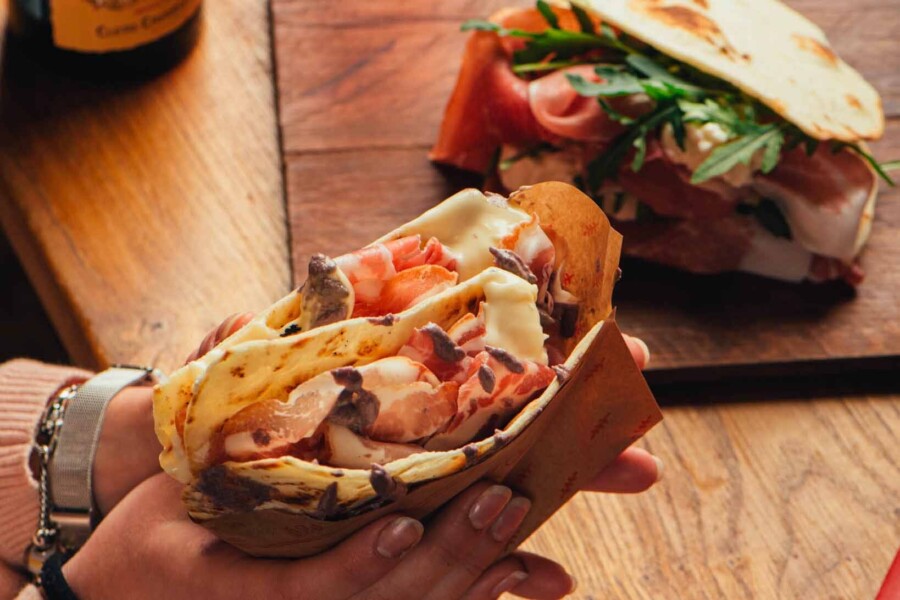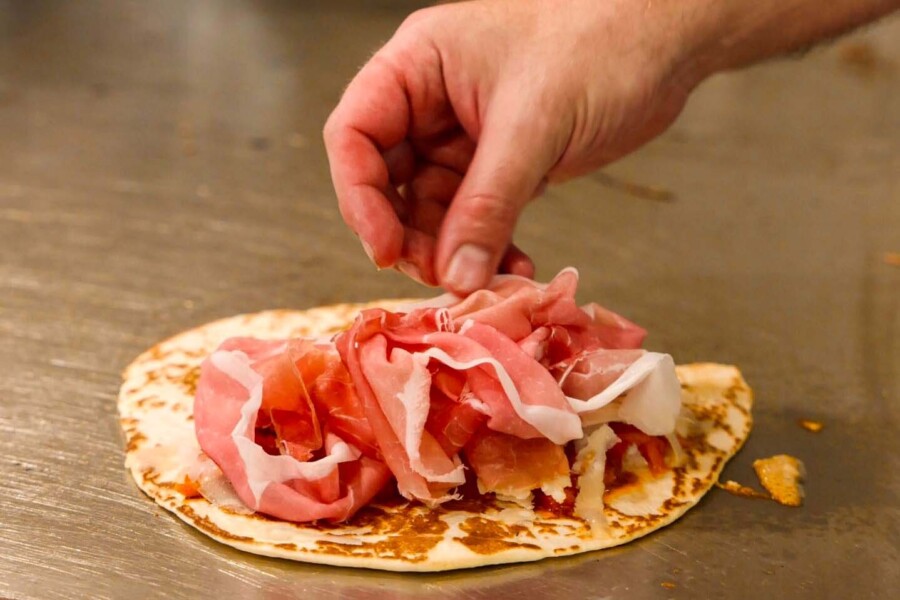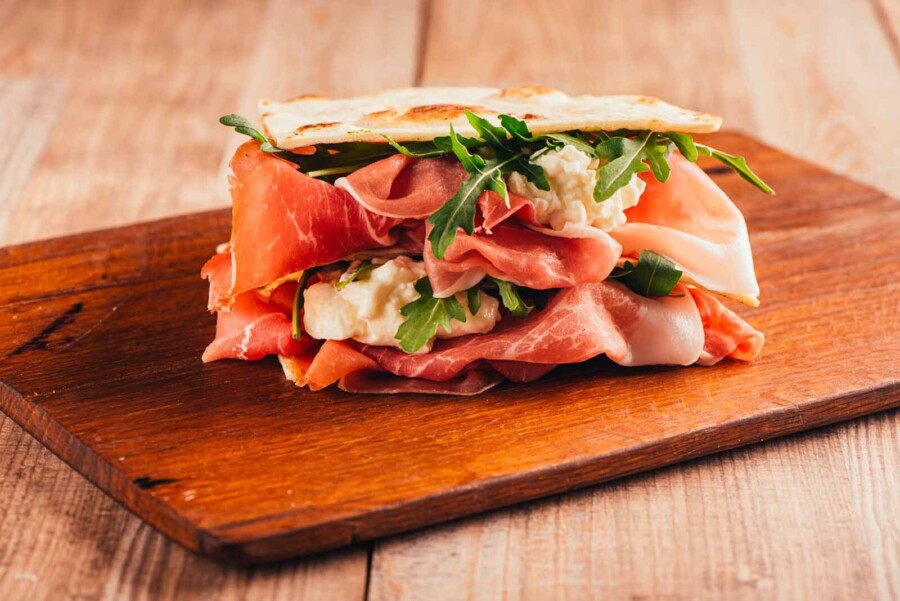Piadina: the iconic flatbread of Romagna

Soft, warm, and incredibly versatile—piadina is one of Italy’s most beloved flatbreads.
Whether you enjoy it filled with creamy squacquerone cheese, prosciutto, and arugula or stuffed with grilled vegetables and a drizzle of olive oil, piadina is the perfect balance of simplicity and flavor.
But what exactly is piadina romagnola?
And why is it so famous in Italy and beyond?
Let’s dive into the history, recipe, and best places to eat this incredible street food.
The history of Piadina
Piadina has deep roots in Romagna, an area within Emilia-Romagna, known for its rich culinary traditions.
This unleavened flatbread has been a staple since ancient times.
Some historians trace its origins back to the Etruscans and Romans, who made similar bread using simple ingredients: flour, water, salt, and fat.
During the Middle Ages, piadina was a humble peasant food, baked on terracotta plates called "teglie".
Over the centuries, its recipe evolved, but its role remained the same: a quick, delicious, and filling bread that pairs well with almost anything.
From Imola to Rimini, piadina changes in thickness: in the north (Imola, Forlì), it’s slightly thicker and softer, while in the south (Rimini, Riccione), it’s thinner and crispier.

What are the different types of Piadina?
- Traditional Piadina Romagnola – the classic version with lard.
- Olive Oil Piadina – a vegetarian-friendly alternative.
- Whole Wheat Piadina – a healthier variation.
- Gluten-Free Piadina – made with rice or chickpea flour.
- Stuffed Piadina (Cassone or Crescione) – folded and sealed with the filling inside, almost like a calzone.
The recipe of Piadina
Piadina Romagnola vs. other flatbreads
Piadina is often compared to other flatbreads, but it has unique characteristics:
- Piadina vs. Tortilla – while Mexican tortillas use masa harina (corn flour), piadina is made with wheat flour. Lard or olive oil gives piadina its rich, soft texture, making it distinctly Italian.
- Piadina vs. Focaccia – Focaccia is thick, fluffy, and baked, while piadina is thin, unleavened, and cooked on a griddle.
- Piadina vs. Naan – Naan is leavened and typically cooked in a tandoor, while piadina remains flat, slightly crispy, and pan-cooked.
Traditional ingredients
To make an authentic piadina romagnola, you need:
- 00 flour – gives piadina its signature soft texture.
- Lard – the traditional fat, adding richness and flexibility. (You can substitute with olive oil for a vegetarian version.)
- Water, salt, and baking soda – essential for binding the dough and adding lightness.

How to make Piadina Romagnola at home
Classic Piadina recipe (step by step)
- Mix ingredients – combine 500g of flour, 125ml of water, 10g of salt, 1 tsp of baking soda, and 50g of lard (or olive oil).
- Knead the dough – work it for about 10 minutes until smooth. Let it rest for 30 minutes.
- Roll out the dough – divide into 4-6 balls and roll them into thin circles (about 2-3mm thick).
- Cook the piadina – heat a griddle or non-stick pan and cook each piadina for 1-2 minutes per side until golden brown.
Tips for achieving the perfect texture
- Don’t over-knead the dough—it should be soft but not sticky
- Cook on high heat for a light crispiness
- Keep the piadina warm in a cloth to preserve its softness
Cooking methods: pan vs. griddle
Traditional piadina is cooked on a terracotta griddle (teglia).
However, a cast iron or non-stick pan works just as well at home.
The best fillings for Piadina
One of the best things about piadina is its versatility.
You can eat it folded like a taco, rolled into a wrap, or layered like a quesadilla.
Here are some of the most popular piadina fillings:
- Classic: Prosciutto di Parma, squacquerone cheese, arugula.
- Cheesy delight: gorgonzola, walnuts, honey.
- Vegetarian: grilled zucchini, eggplant, sun-dried tomatoes, ricotta.
- Seafood: smoked salmon, cream cheese, chives.
- Sweet: Nutella, mascarpone, banana.
How do you eat piadina?
The choice is yours—whether folded, rolled, or stacked, each bite is delicious.

Where to eat the best Piadina in Italy
The best Piadina in Bologna
If you’re in Bologna, don’t miss Sfarinà, located inside the Mercato delle Erbe.
This cozy spot serves handmade piadina with high-quality local ingredients.
The best Piadina in Romagna
For the most authentic piadina romagnola, visit:
📍 Rimini & Riccione – famous for their thin, crispy piadina
📍 Forlì & Cesena – known for thicker, softer versions
📍 Ravenna – a must-visit city for its breathtaking UNESCO mosaics and underrated food scene.
Conclusion
Piadina is more than just bread—it’s a symbol of Romagna’s culinary heritage.
Whether you make it at home or try it at a local piadineria, this simple yet delicious flatbread will steal your heart.
Want to taste freshly made piadina along with other local delicacies?
Join our Ravenna Food Tour, where you'll explore Ravenna food and visit the city's stunning UNESCO mosaics.
👉 Book your tour now and experience the best of Romagna!
[Photo credits: Sfarinà]


